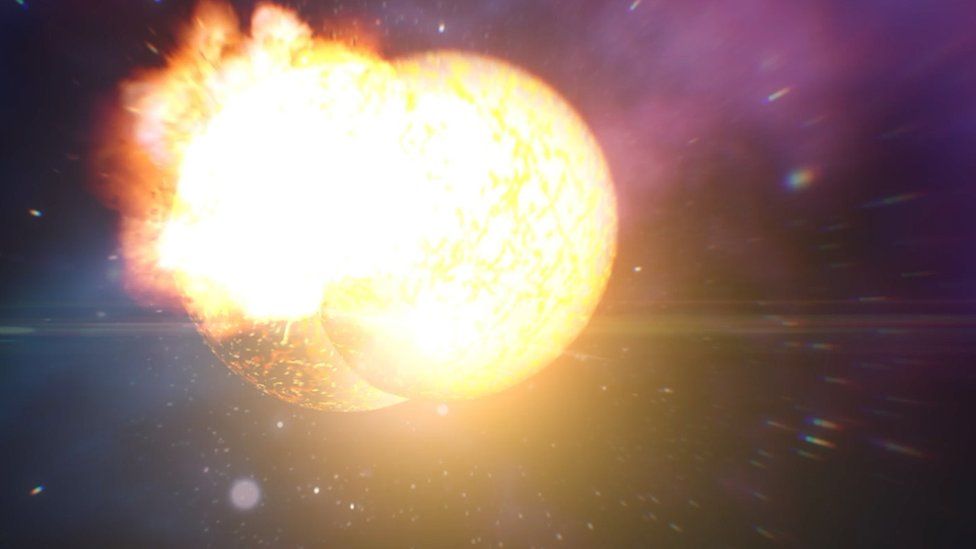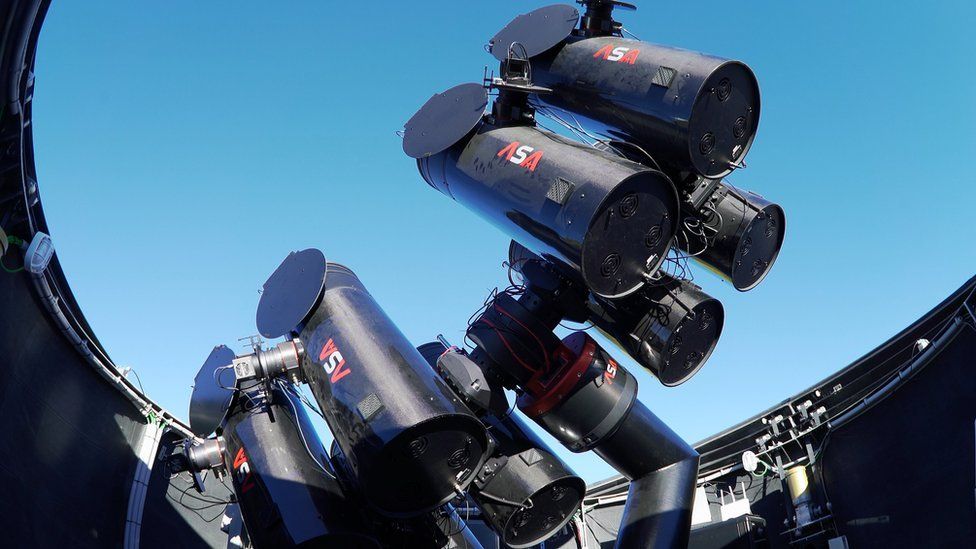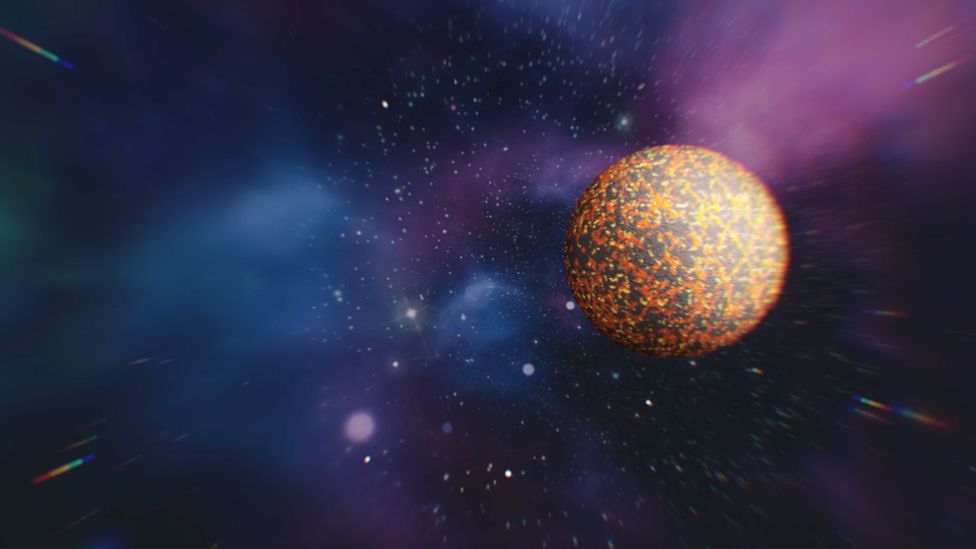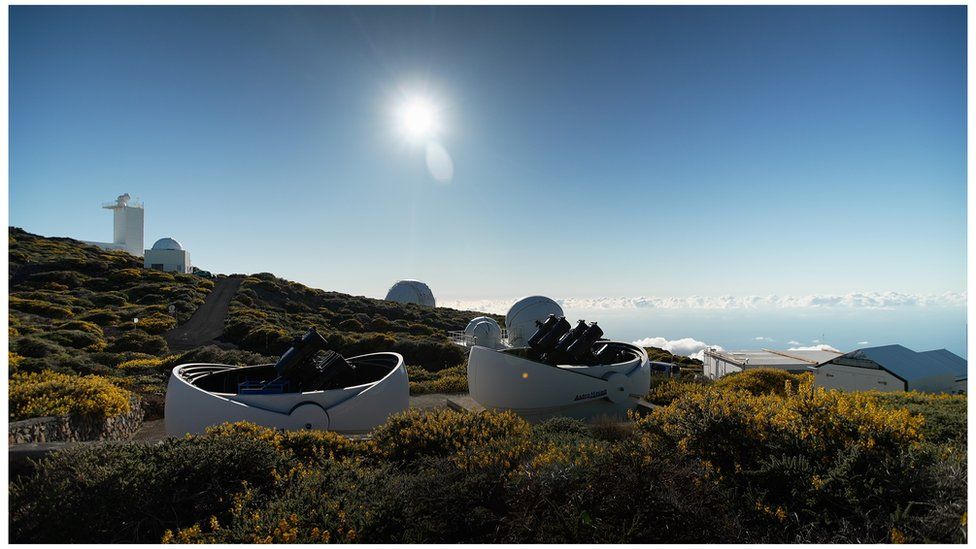 BBC News/Stelios Thoukidides
BBC News/Stelios ThoukididesScientists have developed a new telescope to detect the collisions of dead suns known as neutron stars.
The process is thought to create the heavy metals in the Universe including gold and platinum.
The stars are made from a substance that is so heavy that a small teaspoon weighs four billion tonnes.
I went to see this instrument high in the mountains that allows astronomers to effectively crack open a neutron star to see what is inside.
I met Prof Danny Steeghs, of Warwick University, on the volcanic island of La Palma, Spain. The clouds spread like a white fleecy carpet below us.
The telescope is on a mountain peak, home to a dozen instruments of all shapes and sizes, each studying different phenomena. They gleam in the late afternoon, straw-coloured sunlight scattered across the peak like white and silver sculptures.
This latest addition allows scientists to see neutron stars “being smashed together and observe the rich material that comes out of this explosion,” Danny, who leads the project, tells me.
It was in this environment in space where heavy elements like gold and platinum began to be formed billions of years ago – material that ended up in stars and planets like ours.

BBC News/Kevin Church
Danny’s telescope system is more like artillery than art. As the twin domes open, they reveal two jet-black batteries of eight cylindrical telescopes bolted together. They look like menacing rocket launchers. Each battery covers every patch of sky above it by rapidly rotating vertically and horizontally.
They are designed to be nimble. The light from colliding neutron stars is visible in the night sky for only a couple of days – it is a race against time to pin-point its location.
A neutron star is a dead sun that has collapsed under its immense weight, crushing the atoms that once made it shine. They have such strong gravity that they are drawn to each other. Eventually they crash together and merge.

BBC News/Stelios Thoukidides
When that happens, it creates a flash of light and a powerful shockwave ripples across the Universe. It makes everything in the Universe wobble, including, imperceptibly, the atoms inside of us.
The shockwave, called a gravitational wave, distorts space. When it is detected on Earth, Danny’s telescope, called the gravitational-wave optical transient observer (GOTO), scrambles into action to find the exact location of the flash.
All hands on deck
Astronomers observed one of these collisions in 2017, but it was more by luck than design. Now, GOTO has been built in order to systematically search for then.
“When a really good detection comes along, it’s all hands on deck to make the most of it,” Danny tells me with his typical enthusiasm.
“Speed is of the essence. We are looking for something very short-lived – there’s not much time before they fade away”.

BBC News/Kevin Church
They want to locate flash in the sky within hours, or even minutes of the gravitational wave detection. The researchers take photographs of the sky and then digitally remove the stars, planets and galaxies that were there the previous night. Any spec of light that wasn’t there before may be the colliding neutron stars.
This normally takes days and weeks, but now it must be done in real time. It’s a big task, done using computer software.
“You would think that these explosions are very energetic, very luminous, it should be easy – but we are having to search through a hundred million stars for the one object that we are interested in. We have to do this very rapidly because the object will disappear within two days,” explains Danny’s colleague, Dr Joe Lyman.

BBC News/Kevin Church
Once the astronomers pinpoint the collision, they turn to larger, more powerful telescopes across the world. These probe the collision in much greater detail, and at different wavelengths.
This process is “telling us about physics at the extreme,” Dr Lyman explains.
Gravitational waves – Ripples in the fabric of space-time
- Gravitational waves are a prediction of the Theory of General Relativity
- It took decades to develop the technology to directly detect them
- They are ripples in the fabric of space-time generated by violent events
- Accelerating masses will produce waves that propagate at the speed of light
- Detectable sources ought to include merging black holes and neutron stars
- Ligo/Virgo fire lasers into long, L-shaped tunnels; the waves disturb the light
- Detecting the waves opens up the Universe to completely new investigations
The mountain peak brings the astronomers a little bit closer to the stars. With the telescope they have a new way to peer into the cosmos, says GOTO’s instrumentation scientist, Dr Kendall Ackley.
Traditional astronomy was about being lucky, she says. “Now we’re not hoping for new discoveries anymore. Instead, we’re being told where to find them, and getting to uncover, piece-by-piece what lies out there in the Universe.”
As the sun sets, Danny, Joe and Kendall begin setting up GOTO, in the red and amber glow before nightfall. As they begin their search for the violent collisions far away, they hope it will forever change our understanding of how the Universe came to be.








